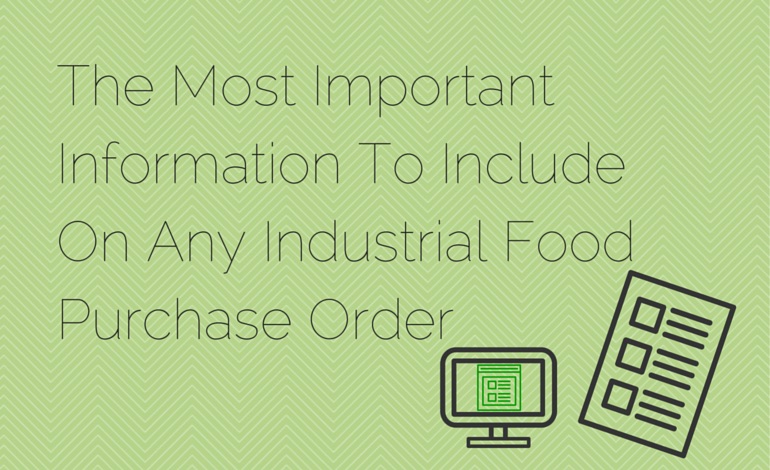
Your order to any supplier is, at the very least, a gentleman’s agreement on both sides. Of course, to be able to get just what you’re looking for, you’ll need to make sure that you include all of the necessary details.
When’s the last time that your ordered a shirt on Amazon and you didn’t have to specify the size, or your shipping address?
In the industrial industry, a purchase order is important to begin with — it’s like a contract. With any contract, you’ll want to make sure that you specify (in writing) the details that you’ve agreed on and make sure that you’ve covered everything that could affect your order.
 Sometimes the details can be wide ranging, and you may not naturally include certain information because it doesn’t directly affect you. That’s why we’ve created a list of all the info that you should make sure to include when you’re putting your orders together.
Sometimes the details can be wide ranging, and you may not naturally include certain information because it doesn’t directly affect you. That’s why we’ve created a list of all the info that you should make sure to include when you’re putting your orders together.
This applies to any industrial food supplier you work with.
Full Product Name
This may seem like an obvious one, but it’s a detail that sometimes people miss. There’s often many different versions of each food, so you’ll want to clarify exactly what grade or type you’re buying. For example, don’t just write olive oil — indicate the full grade. For example, Extra Virgin Olive Oil. Olive Pomace Oil. Refined Olive Oil.
The same thing applies to Canola Oil and other fry oils— do you need the high oleic variation? Non-GMO? Expeller Pressed? There’s lots of different types, so make sure that you specify exactly the oil you are looking for.
Up-To-Date Price
For commodity products like oils, you’ll need to get a price quote each time you order. Commodity pricing changes all the time, so you can be pretty sure that costs will have adjusted since your last order, unless you have a contract.
Depending on the size of your supplier, what their buying strategy is and the type of oil that you’re buying, your prices may change by the hour or by the week.
If the last time you ordered was a few months ago, don’t expect prices to automatically be the same. Commodity markets change all the time, and your prices will adjust to match.
Packaging Type
If you are looking for a particular packaging type, make it very clear on your order. You’ll want to list both the type of packaging (e.g., tote, drum, 35 lb. container) as well as the size and material that you’re looking for (if there is a variation). For example, we carry 5-6 different types of totes— 264, 275, 320, and 330 gallons. They can be made out of IBC hard plastic, bag in a box or have collapsible sides.
If it isn’t indicated on your PO, your supplier won’t know which kind to choose for you, so make sure that you specify. Also, if you want any special attachments like valves, pumps or hoses, make sure that you list those too.
PO Number
Include a PO # so that you can communicate clearly about that specific order. This becomes particularly important when you have more than one order in with your supplier at a time, or when you’re communicating about an old PO.
“Remember that order that we did a couple months ago, when we ordered this, and then this happened?” … Yeah, not very clear. It’s much easier to say, “Remember PO #1982638?” Then both parties are certain that they’re talking about the same thing.
Requested Delivery Date
Always include a requested delivery date on your PO. This is the date that you hope to have your product deliver at your facility.
As a food manufacturer, you’ll always be planning inventory out in advance based on your demand and your suppliers’ lead times.
Of course, it’s nice to take your suppliers’ lead times into account when you’re indicating a requested delivery date, but sometimes you have emergencies— we get it! Just list your hopeful delivery date, and most production teams (at least the ones that are flexible and sometimes able to work with your needs) will let you know what’s realistic given their current schedule .
Keep in mind, many suppliers charge a rush fee, so you’ll have to weigh what’s more important — saving money or getting the product in quickly.
Avoid the urge to order your product for to deliver ASAP. This is a vague term that can mean different things to different people. Does ASAP mean that you want delivery tomorrow, or next month? Are you willing to pay a fee to get it ASAP for real? Specific dates are much clearer and more helpful.
Planned Payment Method
List your agreed upon payment method on your PO. If you have credit terms extended, list the terms and double check that your order is within the limit.
If you don’t have credit extended, discuss the other options for payment and make sure that you indicate which one you’ve chosen so that your suppliers’ accounting and production departments can communicate with you appropriately.
Ship To Address
Make sure that you list your ship to address, especially if it is different from your bill to address.
Also, if your supplier is shipping directly to a customer for you, make sure that you include all of the important shipping contact information like the phone number and a person that they can get in touch with in receiving.
Bill To Address
This one is a given. Just make sure that it’s up to date and present.
Indicate Who Is Arranging The Shipping
Make sure that you indicate on your PO who is arranging the shipping. Are you coordinating a pick up? Do you have all of the information that you’ll need to be able to do that?
If your supplier does it for you, make sure that you indicate that info on your PO. If they’ve already quoted the shipping to you, you can also include that cost in your total.
Additional Documentation Or Shipping Requirements
This is an important one. Every customer has different requirements for receiving inventory.
Do you need specific information listed on the label like a reference number or your company name? Do you have shipping requirements like a lift gate or delivery appointment? Does your facility have dock hours?
List all of this pertinent information to make sure that as your supplier is packing up your products, they’re able to include all of the necessary info that will make the process smooth and easy for your receiving team.
Any Quality Requirements
Make sure to list any quality requirements that you might have for your product. For example, do you need a light color of Pure Olive Oil only? Do you need it to match a particular lot number or flavor profile that you’ve received in the past?
Entering this information will protect you later because you’ve covered all of your bases by being as specific as possible.
Create a Template & Or Use Purchasing Software
This is a lot of information to remember to include on every PO.
It’s easiest to create a template that you can use again and again. You can create it in whatever format you use for purchasing — your purchasing software, excel, word or even in a canned email.
Topics: Purchasing & Procurement












